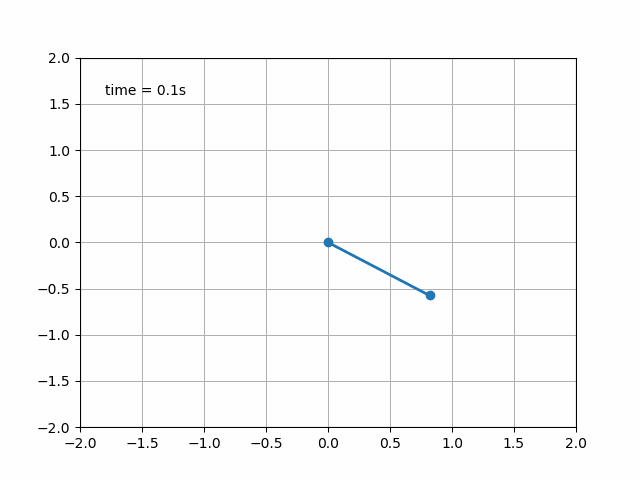Matplotlib 画动态图: animation模块的使用
Matplotlib 画动态图: animation模块的使用
一、总结
一句话总结:
主要还是animation库,以及图片初始化和数据更新:from matplotlib.animation import FuncAnimation
import numpy as np import matplotlib.pyplot as plt from matplotlib.animation import FuncAnimation fig, ax = plt.subplots() xdata, ydata = [], [] ln, = ax.plot([], [], 'r-', animated=False) def init(): ax.set_xlim(0, 2*np.pi) ax.set_ylim(-1, 1) return ln, def update(frame): xdata.append(frame) ydata.append(np.sin(frame)) ln.set_data(xdata, ydata) return ln, ani = FuncAnimation(fig, update, frames=np.linspace(0, 2*np.pi, 128), init_func=init, blit=True) plt.show()
1、python使用imagemagick保存图片?
ani.save('sin.gif', writer='imagemagick', fps=30)
2、pycharm中解决matplotlib画图出现不是动态图的问题?
修改输出图像的设置。 settings->Tools->Python Scientific->Show plots in tool window 取消选中
二、Matplotlib 画动态图: animation模块的使用
转自或参考:Matplotlib 画动态图: animation模块的使用
https://blog.csdn.net/u013180339/article/details/77002254
Gallery — Matplotlib 3.3.0 documentation
https://matplotlib.org/gallery/index.html
matplotlib 画图功能非常强大,目前也只能根据官网 提供的例子简单地画几张图。最近学习了能画动态图的animation模块,作个简单地记录。
在matplotlib作图中,比较常用的是matplotlib.pyplot模块,这个模块有非常多的属性和方法,简要列举下这次用到的方法:
matplotlib.pyplot.subplots(nrows=1, ncols=1, sharex=False, sharey=False, squeeze=True, subplot_kw=None, gridspec_kw=None, **fig_kw)
返回fig和ax对象!
例子1. 动态画出sin函数曲线
import numpy as np
import matplotlib.pyplot as plt
from matplotlib.animation import FuncAnimation
fig, ax = plt.subplots()
xdata, ydata = [], []
ln, = ax.plot([], [], 'r-', animated=False)
def init():
ax.set_xlim(0, 2*np.pi)
ax.set_ylim(-1, 1)
return ln,
def update(frame):
xdata.append(frame)
ydata.append(np.sin(frame))
ln.set_data(xdata, ydata)
return ln,
ani = FuncAnimation(fig, update, frames=np.linspace(0, 2*np.pi, 128),
init_func=init, blit=True)
plt.show()
画这类图的关键是要给出不断更新的函数,这里就是update 函数了。注意, line, = ax.plot([], [], 'r-', animated=False) 中的, 表示创建tuple类型。迭代更新的数据frame 取值从frames 取得。
例子2. 动态显示一个动点,它的轨迹是sin函数。
import numpy as np
import matplotlib.pyplot as plt
from matplotlib import animation
fig, ax = plt.subplots()
x = np.linspace(0, 2*np.pi, 200)
y = np.sin(x)
l = ax.plot(x, y)
dot, = ax.plot([], [], 'ro')
def init():
ax.set_xlim(0, 2*np.pi)
ax.set_ylim(-1, 1)
return l
def gen_dot():
for i in np.linspace(0, 2*np.pi, 200):
newdot = [i, np.sin(i)]
yield newdot
def update_dot(newd):
dot.set_data(newd[0], newd[1])
return dot,
ani = animation.FuncAnimation(fig, update_dot, frames = gen_dot, interval = 100, init_func=init)
ani.save('sin_dot.gif', writer='imagemagick', fps=30)
plt.show()这里我们把生成的动态图保存为gif图片,前提要预先安装imagemagic。
(imagemagic) 直接下载安装即可:
例子3. 单摆(没阻尼&有阻尼)

这里需要用到scipy.integrate的odeint模块,具体用法找时间再专门写一篇blog吧,动态图代码如下:
# -*- coding: utf-8 -*-
from math import sin, cos
import numpy as np
from scipy.integrate import odeint
import matplotlib.pyplot as plt
import matplotlib.animation as animation
g = 9.8
leng = 1.0
b_const = 0.2
# no decay case:
def pendulum_equations1(w, t, l):
th, v = w
dth = v
dv = - g/l * sin(th)
return dth, dv
# the decay exist case:
def pendulum_equations2(w, t, l, b):
th, v = w
dth = v
dv = -b/l * v - g/l * sin(th)
return dth, dv
t = np.arange(0, 20, 0.1)
track = odeint(pendulum_equations1, (1.0, 0), t, args=(leng,))
#track = odeint(pendulum_equations2, (1.0, 0), t, args=(leng, b_const))
xdata = [leng*sin(track[i, 0]) for i in range(len(track))]
ydata = [-leng*cos(track[i, 0]) for i in range(len(track))]
fig, ax = plt.subplots()
ax.grid()
line, = ax.plot([], [], 'o-', lw=2)
time_template = 'time = %.1fs'
time_text = ax.text(0.05, 0.9, '', transform=ax.transAxes)
def init():
ax.set_xlim(-2, 2)
ax.set_ylim(-2, 2)
time_text.set_text('')
return line, time_text
def update(i):
newx = [0, xdata[i]]
newy = [0, ydata[i]]
line.set_data(newx, newy)
time_text.set_text(time_template %(0.1*i))
return line, time_text
ani = animation.FuncAnimation(fig, update, range(1, len(xdata)), init_func=init, interval=50)
#ani.save('single_pendulum_decay.gif', writer='imagemagick', fps=100)
ani.save('single_pendulum_nodecay.gif', writer='imagemagick', fps=100)
plt.show() 
例子4. 滚动的球
import numpy as np
import matplotlib.pyplot as plt
import matplotlib.animation as animation
fig = plt.figure(figsize=(6, 6))
ax = plt.gca()
ax.grid()
ln1, = ax.plot([], [], '-', lw=2)
ln2, = ax.plot([], [], '-', color='r', lw=2)
theta = np.linspace(0, 2*np.pi, 100)
r_out = 1
r_in = 0.5
def init():
ax.set_xlim(-2, 2)
ax.set_ylim(-2, 2)
x_out = [r_out*np.cos(theta[i]) for i in range(len(theta))]
y_out = [r_out*np.sin(theta[i]) for i in range(len(theta))]
ln1.set_data(x_out, y_out)
return ln1,
def update(i):
x_in = [(r_out-r_in)*np.cos(theta[i])+r_in*np.cos(theta[j]) for j in range(len(theta))]
y_in = [(r_out-r_in)*np.sin(theta[i])+r_in*np.sin(theta[j]) for j in range(len(theta))]
ln2.set_data(x_in, y_in)
return ln2,
ani = animation.FuncAnimation(fig, update, range(len(theta)), init_func=init, interval=30)
ani.save('roll.gif', writer='imagemagick', fps=100)
plt.show()
pycharm中解决图出现不是动态图的问题
方案1. 修改输出图像的设置。 settings->Tools->Python Scientific->Show plots in tool window 取消选中
方案2. 在导入import matplotlib.pyplot as plt 之前,运行import matplotlib; matplotlib.use('TkAgg') 修改输出方式
还有就是保存的图片直接用pycharm打开是静态图,使用系统自带的图片编辑器打开是动态的。



